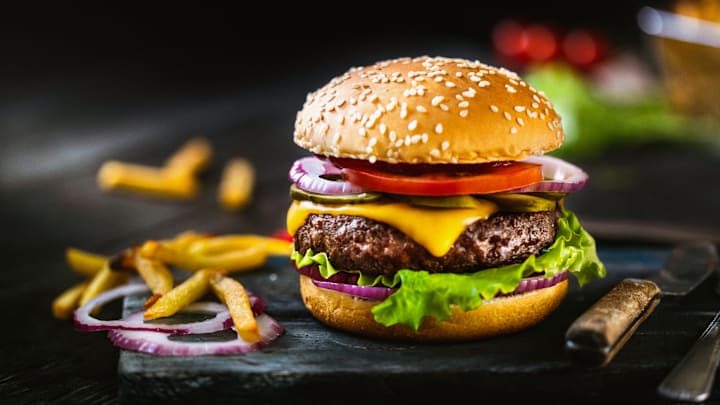Close your eyes and picture a hamburger. Whether the version in your imagination is bursting with lettuce and tomatoes and oozing ketchup or not, it’s a sure bet that the image in your mind’s eye includes a bun. Without a bun it’s not a hamburger, though—it’s just a hamburger patty, or what used to be known as a hamburger steak (or hamburg steak).
If you’ve ever found yourself wondering who invented the first hamburger, you’re not alone. Below, discover more fascinating details about the history of hamburgers, from their minced beef-with-suet recipe origins to White Castle’s legendary “sliders,” and more.
Table of Contents
- From Hamburg Sausage to Hamburg Steak
- Read More About Food History:
- Hamburg Steak vs. Hamburger: What’s the Difference?
- Who Invented the Modern Hamburger?
From Hamburg Sausage to Hamburg Steak
Exactly how a dish named for a German city evolved into one of America’s favorite foods is a riddle wrapped in a mystery on a sesame seed bun.
The earliest reference to the ancestor of the hamburger appears in an English cookbook from 1763. In Art of Cookery, Made Plain and Easy, Hannah Glasse explains how to make a Hamburgh sausage. The recipe calls for mixing minced beef with suet, spices, wine, and rum and stuffing it into a gut, which is then smoked and dried. Except for those final steps of converting it into a sausage, the minced meat and fat with spices could be considered a hamburg steak, which is defined as a dish of salted and smoked minced beef.

The first glimpse of hamburg steak occurred around the 1870s, when this dish began popping up in restaurants. In San Francisco, a menu from the Clipper Restaurant dated 1871 to 1884 lists Hamburg beefsteak for 10 cents, the same price as stewed mutton, tripe, or salmon. A tenderloin steak was 20 cents.
Read More About Food History:
Hamburg Steak vs. Hamburger: What’s the Difference?
Quite simply, a hamburger is a sandwich served on a bun instead of sandwich bread, while hamburg steak is a meal itself (although it was often served with bread on the side.) But who turned a hamburg steak into “the hamburger” by placing it on a bun? Zigzagging across the country again, we find many contenders. According to the Library of Congress, Louis’ Lunch Wagon in New Haven, Connecticut, served the first hamburgers in 1895. But their hamburger sandwiches were served between slices of bread. Close, but not the real deal.
There are more tantalizing hints. In 1891, The Boston Globe ran an ad for a butcher shop, which was offering up a cookbook with a recipe for “hamburger on toast.” Then in August 1893, an ad in the Reno Gazette-Journal appeared for hamburger steak sandwiches at a local saloon, even boasting that they could “replenish an empty stomach and fortify even Satan himself.”
According to an oft-repeated story, Fletcher Davis, a fry cook from the tiny town of Athens, Texas, popularized the hamburger sandwich at the 1904 St. Louis World’s Fair. In Josh Ozersky’s The Hamburger: A History, however, the author claims that Frank X. Tolbert, the late columnist for the Dallas Morning News, concocted the story.
Who Invented the Modern Hamburger?
It is very likely that hamburgers naturally evolved from restaurants serving hamburger steak with bread on the side back in the late 1800s. In all likelihood, many a burger was borne on a bun unseen, to waste its perfume in some forgotten lunchroom.

But in 1916, fry cook Walter Anderson of Wichita, Kansas, developed a dense bun with a crisp crust that was capable of holding up to the juiciest hamburger. By 1921, the Original Slider was born.
So, sorry, Mickey D, Wendy, and all the anonymous lunch wagon proprietors and family picnickers. At least for now, Anderson—the founder of White Castle, the first fast-food hamburger chain in the U.S.—holds the title of inventor of the modern-day hamburger.
A version of this story ran in 2014; it has been updated for 2024.
